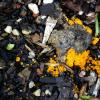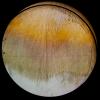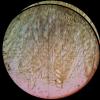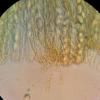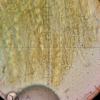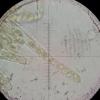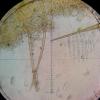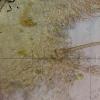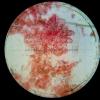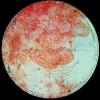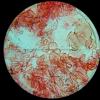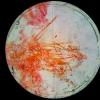
20-12-2025 23:08
Patrice TANCHAUDBonsoir, récolte sur sol sablonneux dans l'arri�

21-12-2025 09:32
Hello.A tiny ascomycete found embedded in wood in

20-12-2025 15:47
Mirek GrycHi.These grew on pine wood that was heavily covere

18-12-2025 21:17
Pol DebaenstThe identification took me to Byssonectria deformi

15-12-2025 07:09
 Danny Newman
Danny Newman
indet. Rutstroemiaceae sp. on unk. fallen leavesMc

19-12-2025 10:10
Patrice TANCHAUDBonjour, récolte réalisée en milieu dunaire, a

18-12-2025 17:23
 Bruno Coué
Bruno Coué
Bonjour,je serais heureux d'avoir votre avis sur c
Yellow Discomycete
Danny Newman,
20-12-2014 07:06
 This was found in a landscaped/garden area in urban San Francisco, CA. It is growing on woodchips and possibly a piece of dung, possibly belonging to a housecat. Some hyphae seem to possess yellow contents, particularly just beneath the hymenium. The asci are 8-spored, seemingly inoperculate with inamyloid tips. The paraphyses tips appear to be apically encrusted. No septa were observed in the spores.
This was found in a landscaped/garden area in urban San Francisco, CA. It is growing on woodchips and possibly a piece of dung, possibly belonging to a housecat. Some hyphae seem to possess yellow contents, particularly just beneath the hymenium. The asci are 8-spored, seemingly inoperculate with inamyloid tips. The paraphyses tips appear to be apically encrusted. No septa were observed in the spores.Also at http://mushroomobserver.org/194082
Any and all help greatly appreciated.
-Danny
Hans-Otto Baral,
20-12-2014 07:14

Re : Yellow Discomycete
Hi Danny
to me the fungus looks operculate, but I am not sure. This could be clarified by a closeup of the ascus apex, especially if you find opered, emptied asci. Also a section of the ectal excipulum would be valuable (cell size?).
Did you see any free spores? What is their size?
Zotto
to me the fungus looks operculate, but I am not sure. This could be clarified by a closeup of the ascus apex, especially if you find opered, emptied asci. Also a section of the ectal excipulum would be valuable (cell size?).
Did you see any free spores? What is their size?
Zotto
Danny Newman,
20-12-2014 07:25

Re : Yellow Discomycete
Zotto,
Thank you for your prompt and informative reply. We have taken the undried portion of the collection and placed it in a moisture chamber. Hopefully with time the spores will begin to be discharged and the operculum will be more noticeable. There were no spores observed floating in the medium, nor any open asci, leading us to believe that this is either inoperculate or still immature.
Will also post back with ectal excipular cell measurements shortly.
Many thanks,
-Danny
Thank you for your prompt and informative reply. We have taken the undried portion of the collection and placed it in a moisture chamber. Hopefully with time the spores will begin to be discharged and the operculum will be more noticeable. There were no spores observed floating in the medium, nor any open asci, leading us to believe that this is either inoperculate or still immature.
Will also post back with ectal excipular cell measurements shortly.
Many thanks,
-Danny
Danny Newman,
20-12-2014 08:34

Re : Yellow Discomycete
We measured a range of ectal excipular cells, finding both small ones and large ones. Their measurements are as follows:
26 x 33
27.5 x 45
30 x 43.75
33.75 x 50
12.5 x 19
11.5 x 15
12.5 x 17.5
Attached are images of these cells at both 400x and 1000x, as well as some septate, lanceolate hairs seen on the surface of the ectal excipulum at 400x, and finally a somewhat blurry image of the yellow-filled hyphae at 1000x.
26 x 33
27.5 x 45
30 x 43.75
33.75 x 50
12.5 x 19
11.5 x 15
12.5 x 17.5
Attached are images of these cells at both 400x and 1000x, as well as some septate, lanceolate hairs seen on the surface of the ectal excipulum at 400x, and finally a somewhat blurry image of the yellow-filled hyphae at 1000x.
Hans-Otto Baral,
20-12-2014 08:42

Re : Yellow Discomycete
yes, these large cells and the brownish setae point to the genus Cheilymenia. I am not an expert in that group.
Zotto
Zotto
Danny Newman,
20-12-2014 09:05

Re : Yellow Discomycete
Thank you, Zotto. Indeed, a look at the rest of the requisite microcharacters for Cheilymenia make it a good match for this material. Cheilymenia theleboloides did not appear to be a perfect fit going by Fungi of Switzerland's description, since it describes the hairs as hyaline. Ascomycetes in Colour, however, describes them as hyaline to yellowish-brown. All other microcharacters described from both texts are consistent with our observations. The only remaining feature to check is the longitudinal striations in the mature spores, which we should be able to observe one the material has sat in its moisture chamber for a few days.
Thank you again for your kind assistance.
-Danny, Alan and Sava.
Thank you again for your kind assistance.
-Danny, Alan and Sava.
René Dougoud,
20-12-2014 10:42
Re : Yellow Discomycete
Cher Collègue,
L'appartenance de votre récolte au genre Cheilymenia ne fait aucun doute. Malheureusement les informations que vous donnez et les photos que vous présentez ne sont pas très utiles ou suffisamment explicites pour permettre de déterminer l'espèce.
Le premier caractère à déterminer dans ce genre et le type d'ornementation sporal, ceci dans le bleu coton lactique et au plus fort grossissement, puis leur dimension. Ensuite il faut surtout observer la présence éventuelle de poils en forme d'étoile, la forme basale des poils, notamment des poils sétiformes, puis les mesurer, leur couleur est importante, mais elle peut varier. Enfin il faut définir les textures des strates composant la chair. Après seulement il sera certainement possible de déterminer l'espèce.
Le genre Cheilymenia étant très interessant et les espèces nombreuses, mais assez difficiles à déterminer, je vous conseille la monographie de Jiri Moravec (2005) « A Wold Monograph of the genus Cheilymenia » Libri Botanici vol. 21 , 256 p. IHW-Verlag, ISBN 3-930167-62-x.
René
L'appartenance de votre récolte au genre Cheilymenia ne fait aucun doute. Malheureusement les informations que vous donnez et les photos que vous présentez ne sont pas très utiles ou suffisamment explicites pour permettre de déterminer l'espèce.
Le premier caractère à déterminer dans ce genre et le type d'ornementation sporal, ceci dans le bleu coton lactique et au plus fort grossissement, puis leur dimension. Ensuite il faut surtout observer la présence éventuelle de poils en forme d'étoile, la forme basale des poils, notamment des poils sétiformes, puis les mesurer, leur couleur est importante, mais elle peut varier. Enfin il faut définir les textures des strates composant la chair. Après seulement il sera certainement possible de déterminer l'espèce.
Le genre Cheilymenia étant très interessant et les espèces nombreuses, mais assez difficiles à déterminer, je vous conseille la monographie de Jiri Moravec (2005) « A Wold Monograph of the genus Cheilymenia » Libri Botanici vol. 21 , 256 p. IHW-Verlag, ISBN 3-930167-62-x.
René

